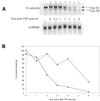Fully modified 2' MOE oligonucleotides redirect polyadenylation
- PMID: 11238995
- PMCID: PMC29745
- DOI: 10.1093/nar/29.6.1293
Fully modified 2' MOE oligonucleotides redirect polyadenylation
Abstract
Many genes have been described and characterized that have alternative polyadenylation signals at the 3'-end of their pre-mRNAs. Many of these same messages also contain destabilization motifs responsible for rapid degradation of the mRNA. Polyadenylation site selection can thus determine the stability of an mRNA. Fully modified 2'-O:-methoxy ethyl/phosphorothioate oligonucleotides that hybridize to the 3'-most polyadenylation site or signal of E-selectin were able to inhibit polyadenylation at this site and redirect it to one of two upstream cryptic sites. The shorter transcripts produced after antisense treatment have fewer destabilization sequences, increased mRNA stability and altered protein expression. This study demonstrates that antisense oligonucleotides can be successfully employed to redirect polyadenylation. This is the first demonstration of the use of oligonucleotides to increase, rather than decrease, abundance of a message.
Figures





Similar articles
-
Implications of polyadenylation in health and disease.Nucleus. 2014;5(6):508-19. doi: 10.4161/nucl.36360. Epub 2014 Oct 31. Nucleus. 2014. PMID: 25484187 Free PMC article. Review.
-
The mouse Krüppel-like Factor 4 (Klf4) gene: four functional polyadenylation sites which are used in a cell-specific manner as revealed by testicular transcript analysis and multiple processed pseudogenes.Gene. 2005 Nov 21;361:149-56. doi: 10.1016/j.gene.2005.07.025. Epub 2005 Sep 26. Gene. 2005. PMID: 16185820
-
Upstream elements present in the 3'-untranslated region of collagen genes influence the processing efficiency of overlapping polyadenylation signals.J Biol Chem. 2002 Nov 8;277(45):42733-40. doi: 10.1074/jbc.M208070200. Epub 2002 Aug 27. J Biol Chem. 2002. PMID: 12200454
-
Presence of multiple functional polyadenylation signals and a single nucleotide polymorphism in the 3' untranslated region of the human serotonin transporter gene.J Neurochem. 1999 Apr;72(4):1384-8. doi: 10.1046/j.1471-4159.1999.721384.x. J Neurochem. 1999. PMID: 10098839
-
Papillomavirus transcripts and posttranscriptional regulation.Virology. 2013 Oct;445(1-2):187-96. doi: 10.1016/j.virol.2013.04.034. Epub 2013 May 23. Virology. 2013. PMID: 23706315 Review.
Cited by
-
Post-transcriptional control of haemostatic genes: mechanisms and emerging therapeutic concepts in thrombo-inflammatory disorders.Cardiovasc Res. 2023 Jul 6;119(8):1624-1640. doi: 10.1093/cvr/cvad046. Cardiovasc Res. 2023. PMID: 36943786 Free PMC article. Review.
-
TDP-43 dysregulation of polyadenylation site selection is a defining feature of RNA misprocessing in amyotrophic lateral sclerosis and frontotemporal dementia.J Clin Invest. 2025 Jun 2;135(11):e182088. doi: 10.1172/JCI182088. eCollection 2025 Jun 2. J Clin Invest. 2025. PMID: 40454469 Free PMC article.
-
Assembling the RNA therapeutics toolbox.Med Rev (2021). 2024 Mar 20;4(2):110-128. doi: 10.1515/mr-2023-0062. eCollection 2024 Apr. Med Rev (2021). 2024. PMID: 38680684 Free PMC article. Review.
-
Antisense technology: an overview and prospectus.Nat Rev Drug Discov. 2021 Jun;20(6):427-453. doi: 10.1038/s41573-021-00162-z. Epub 2021 Mar 24. Nat Rev Drug Discov. 2021. PMID: 33762737 Review.
-
Antisense oligonucleotides: treating neurodegeneration at the level of RNA.Neurotherapeutics. 2013 Jul;10(3):486-97. doi: 10.1007/s13311-013-0194-5. Neurotherapeutics. 2013. PMID: 23686823 Free PMC article. Review.
References
-
- Gautheret D., Poirot,O., Lopez,F., Audic,S. and Claverie,J.M. (1998) Alternate polyadenylation in human mRNAs: a large-scale analysis by EST clustering. Genome Res., 8, 524–530. - PubMed
-
- Shaw G. and Kamen,R. (1986) A conserved AU sequence from the 3′ untranslated region of GM-CSF mRNA mediated selective mRNA degradation. Cell, 46, 659–667. - PubMed
-
- Wahle E. and Keller,W. (1996) The biochemistry of polyadenylation. Trends Biochem. Sci., 21, 247–250. - PubMed
MeSH terms
Substances
LinkOut - more resources
Full Text Sources
Other Literature Sources

